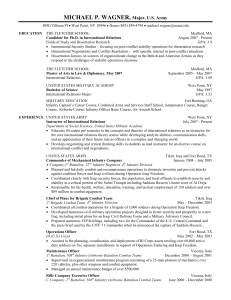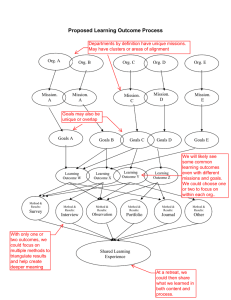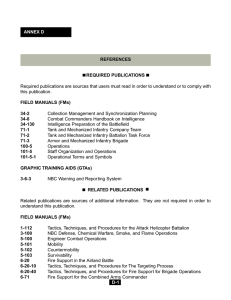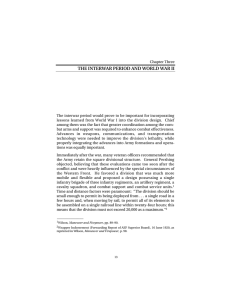A C S H U . S . L
advertisement
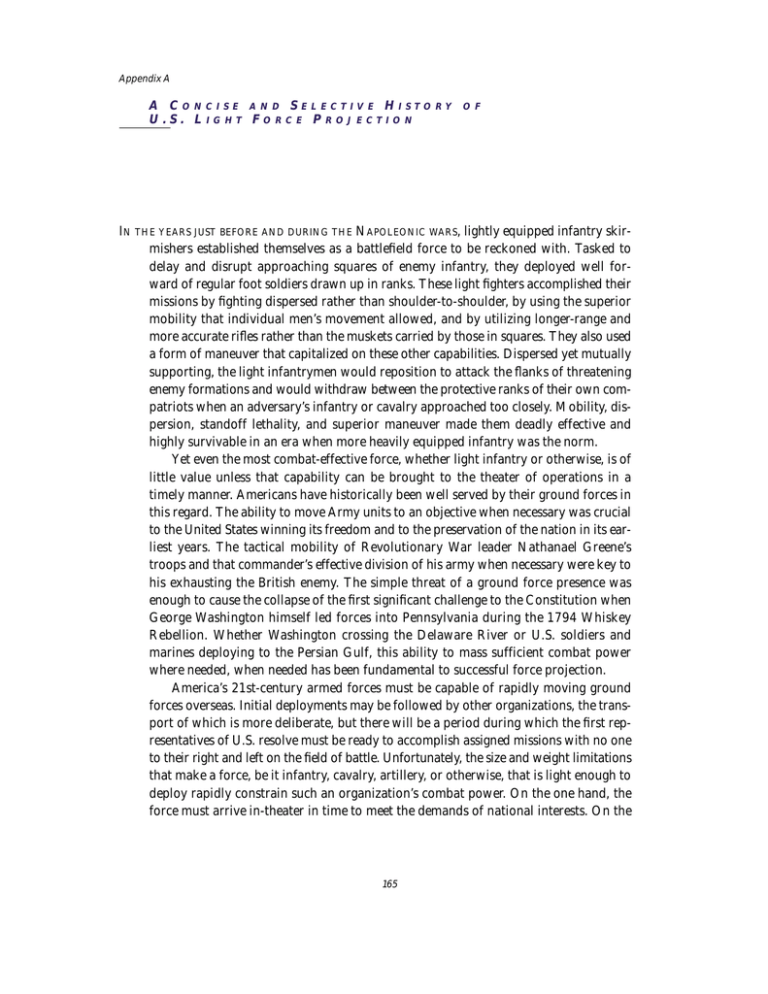
Appendix A A CONCISE AND SELECTIVE HISTO U.S. LIGHT FORCE PROJECTION RY O F IN THE YEARS JUST BEFORE AND DURING THE NAPOLEONIC WARS, lightly equipped infantry skirmishers established themselves as a battlefield force to be reckoned with. Tasked to delay and disrupt approaching squares of enemy infantry, they deployed well forward of regular foot soldiers drawn up in ranks. These light fighters accomplished their missions by fighting dispersed rather than shoulder-to-shoulder, by using the superior mobility that individual men’s movement allowed, and by utilizing longer-range and more accurate rifles rather than the muskets carried by those in squares. They also used a form of maneuver that capitalized on these other capabilities. Dispersed yet mutually supporting, the light infantrymen would reposition to attack the flanks of threatening enemy formations and would withdraw between the protective ranks of their own compatriots when an adversary’s infantry or cavalry approached too closely. Mobility, dispersion, standoff lethality, and superior maneuver made them deadly effective and highly survivable in an era when more heavily equipped infantry was the norm. Yet even the most combat-effective force, whether light infantry or otherwise, is of little value unless that capability can be brought to the theater of operations in a timely manner. Americans have historically been well served by their ground forces in this regard. The ability to move Army units to an objective when necessary was crucial to the United States winning its freedom and to the preservation of the nation in its earliest years. The tactical mobility of Revolutionary War leader Nathanael Greene’s troops and that commander’s effective division of his army when necessary were key to his exhausting the British enemy. The simple threat of a ground force presence was enough to cause the collapse of the first significant challenge to the Constitution when George Washington himself led forces into Pennsylvania during the 1794 Whiskey Rebellion. Whether Washington crossing the Delaware River or U.S. soldiers and marines deploying to the Persian Gulf, this ability to mass sufficient combat power where needed, when needed has been fundamental to successful force projection. America’s 21st-century armed forces must be capable of rapidly moving ground forces overseas. Initial deployments may be followed by other organizations, the transport of which is more deliberate, but there will be a period during which the first representatives of U.S. resolve must be ready to accomplish assigned missions with no one to their right and left on the field of battle. Unfortunately, the size and weight limitations that make a force, be it infantry, cavalry, artillery, or otherwise, that is light enough to deploy rapidly constrain such an organization’s combat power. On the one hand, the force must arrive in-theater in time to meet the demands of national interests. On the 165 166 L I G HTN I N G OVE R W ATE R other, it must possess the firepower, mobility, maneuver capability, and survivability to accomplish the tasks essential to fulfilling those demands. In a world where even the poorest of nations can probably field an armored or mechanized force of some strength, this dichotomy between speed and combat power poses what is perhaps a force projection military’s greatest challenge. Light forces, equipped with lighter and smaller systems designed to maximize attainable combat power, are an effort to answer this challenge. The forerunners of today’s light forces were often the tools deployed to defend the nation’s interests. In the young nation’s first overseas land operation (notably, a joint undertaking), U.S. naval agent William Eton crossed six hundred miles of north African desert in April 1805 with a force of eight marines, one Navy midshipman, and some one hundred mercenaries in an effort to force the release of U.S. Navy prisoners of war (Dupuy and Dupuy, 1977, pp 780–781). Ulysses S. Grant broke away from a burdensome logistical tail and completed one of the great feats of American maneuver to wreak havoc in Mississippi and eventually capture Vicksburg on July 4, 1863. Mobility and the ability of light cavalry to operate in small, dispersed units were keys to the U.S. stabilization of the 19th-century American west. It was not until World War II, however, that U.S. ground force projection escaped terra firma. Although generally limited to intratheater operations such as airborne drops in support of the Normandy invasion, aircraft had become an accepted means of transporting men and materiel onto the battlefield by the 1940s. A new era of far more rapid application of military force was at hand. Yet the additional speed and freedom from ground obstacles came with costs. Previously, unless the exigencies of extraordinary mission demands precluded it, America’s marines and soldiers generally reached their destinations with equipment on par with if not superior to that of their adversaries. Air transport often precluded achievement of this parity. Size and weight restrictions set sharp upper bounds on the capabilities with which a force could deploy. As mechanization and armored vehicles came of age, forces that could reach a theater by air found themselves outclassed when it came to firepower and protection. The same characteristics that had aided America’s light force predecessors (mobility on difficult terrain and the ability to disperse to reduce the likelihood of detection or effective engagement) were now not merely valuable, they had become essential to survival. Air-dependent force projection operations also demonstrated that light forces could defeat heavier adversaries despite these constraints to achieve dramatic successes. The use of airborne units to secure key transportation nodes in support of the Normandy invasion served to both disrupt German decisionmaking and facilitate movement inland once amphibious units landed and fought their way off the beaches. Avoiding or outmaneuvering fixed defensive positions permitted foot-mobile paratroopers to move to their objectives and dig in before armor or mechanized threats could be brought to bear. The greatest threat to these operations, enemy air, was kept at arm’s length while men and equipment dropped from the skies, reorganized, and accomplished their assigned missions. In the Pacific theater, the 11th Airborne Division’s A CONCISE AN D S E L ECTIVE H I STO RY OF U.S. L I G HT F O RC E P ROJ ECTI O N successful February 1945 Los Baños raid, conducted to free prisoners of war from the Japanese, similarly combined air, sea, and land capabilities, good intelligence, and wellconceived mission design to allow these light forces to accomplish their difficult mission. When missions were chosen less wisely, however, or when intelligence failed, light forces could be grossly outclassed by the firepower an enemy could bring to bear. The failure of the combined U.S.-British Operation Market Garden in 1944 was in considerable part attributable to the Allies being unable to overcome German 9th and 10th Panzer Division elements sent into the objective area shortly before the offensive (Devlin, 1979, p. 479). Similarly, the presence of enemy armor at Avellino had earlier complicated an already risky mission for the 509th Parachute Battalion during its late 1943 support of the Salerno bridgehead: The paratroopers had advanced nearly two miles when an alert German sentinel sent them diving for roadside ditches with a long burst from his machine gun. Off in the direction of the gunfire, the paratroopers could see the distinct outlines of several tanks . . . There were tanks in the crossroads area, and plenty of them. More than a battalion . . . The Germans had them outgunned. Machine gunners buttoned up inside the tanks started spraying the area, cutting down any paratroopers foolhardy enough to come close to them. The paratroopers fired back, but their bullets bounced harmlessly off the tanks. Several flares shot high into the sky cast an eerie red glow over the battlefield and exposed every paratrooper not lying in a ditch. One by one the Germans picked them off. (Devlin, 1979, pp. 311–312.) Though author John English might conclude that “infantry that has neither the means nor inclination to fight on its own is hardly worthy of the name,” the reality was quite simply that lift capabilities supporting rapid long-range movements kept these early air-transported forces from having sufficient firepower and mobility to confront a well-equipped adversary of any sophistication (English, 1984, p. 218). This inevitable tension between deployability and combat power carried over into the Cold War, during which strategic movement of light forces played an integral role in defense plans for Western Europe. The presence of U.S. mechanized and armored divisions in Germany lent a ready means of supporting what were likely to be the first ground force reinforcements to arrive from the United States. Light forces were often assigned to heavier units during training to exercise potential wartime relationships. Planners in Europe accounted for the limited mobility of the light force soldier. Footmobile organizations were habitually ordered to defend key terrain, generally forested or urban, that provided concealment and the means to construct defenses against Warsaw Pact artillery, armor, and air attacks. Exercise results showed that ill-conceived assignment to easily bypassed or overrated terrain left the relatively immobile force behind enemy lines with little hope of resupply or extraction. Well-selected terrain, or missions that took advantage of light force stealth and dispersion, demonstrated that heavy and light organizations could at times work effectively together when the relative strengths and weaknesses of each were taken into account (see also Glenn, 1990, pp. 35–37). Nevertheless, both command post and field training events repeatedly 167 168 L I G HTN I N G OVE R W ATE R showed that light force disadvantages in maneuver, firepower, and survivability often threatened mission success when light units were pitted against tanks, infantry fighting vehicles, and enemy air on West European terrain. Operation Just Cause pitted Americans against some 4,000 Panamanian Defense Force (PDF) combat troops in late 1989. It also demonstrated what light force maneuver and firepower parity could accomplish. The Panamanians’ heaviest equipment consisted of 28 armored cars. Other units included 18 paramilitary Dignity Battalions (Cole, 1995, p. 37). In addition to Marine Corps and Army light armor and mechanized elements, the U.S. force included soldiers from the 7th Infantry Division (Light), paratroopers of the 82nd Airborne Division, 6th Expeditionary Battalion Marines, the Army’s 193rd Infantry Brigade (based in Panama), and special operations forces. Initial U.S. light force missions included the seizure of key terrain and the destruction of known enemy forces located in and around Panama City and the canal. Wise allocation of objectives was critical to the ultimate outcome. Missions requiring extensive movement, such as the attack on La Comandancia, were given to units equipped with or supported by light tanks or armored personnel carriers (APCs). Light forces accompanying these organizations rode in the APCs until near the objective. Airborne and special operations forces were dropped on or near their objectives to try to surprise the adversary and minimize ground movement times. When possible, attack helicopters or AC-130 aircraft provided fire support. The conscious effort to match capabilities with missions led to few confrontations in which the Americans did not have the advantage. Christmas 1989 in Panama, Christmas 1990 in the Persian Gulf: Less than a year after its participation in Operation Just Cause, the soldiers of the 82nd Airborne joined their compatriots in the 101st Airborne (Air Assault) and 24th Mechanized Divisions in the defense of Saudi Arabia, Operation Desert Shield. Again it was the light fighter who was first on the ground, but in the deserts of the Middle East the threat was far more intimidating than that posed by 28 armored cars. The invaders of Kuwait counted their tanks, infantry fighting vehicles, artillery pieces, and other heavy armament by the thousands. Between the Iraqi enemy and Saudi Arabia’s invaluable ports stood little more than a screen of Arab units and a thin red, white, and blue line of 82nd Airborne Division soldiers. Whether because of the U.S. presence, the logistical difficulties inherent in supporting the long attack south, or a combination of these and other reasons, the enemy failed to continue its southward movement. Outgunned and at a severe mobility disadvantage in the open desert terrain, the mettle of the Americans would have been seriously tested had the attack taken place. At 7:00 P.M., September 18, 1994, 16 United States Air Force C-130 aircraft loaded with paratroopers were en route to Haiti. A second group stood poised on North Carolina runways to follow them. To the south, at Fort Stewart, Georgia, Army Rangers likewise readied to don parachutes. These soldiers’ collective objective was “to return to office the democratically elected president of that country and the creation of a stable and secure environment in which democratic institutions could take hold.” Eventually a total of 62 aircraft loaded with fighting men and equipment A CONCISE AN D S E L ECTIVE H I STO RY OF U.S. L I G HT F O RC E P ROJ ECTI O N would be in the air, destined for combat insertion at critical locations (Kretchik, Baumann, and Fishel, 1998, pp. ix and 76). In the closing moments before the Americans jumped into the night air, a political settlement caused a dramatic change of mission from one of forcible entry to permissive landings. As had been the case in Pennsylvania over two hundred years before, the approach of the American force had been threat enough to bring about the attainment of national objectives. History demonstrates that light forces can serve U.S. interests through both the actual commitment to combat operations and the mere threat of such commitment. As there can be no guarantee that the coercive effect will be sufficient, America’s force projection capability must be a capable one if it is to serve as an effective implement of policy. In addition to those events highlighted above, Korea, the Dominican Republic, Vietnam, Grenada, Somalia, and myriad other post–World War II operations have, for better or worse, confirmed the validity of this requirement. In today’s world, that sufficiency often demands speed in application and successful execution once a force arrives in a theater. However, as has been the case since air deployment began during World War II, speed and the delivery of sufficient combat power are elements in tension. Speed is possible only with the deployment of lighter forces; light forces as of yet suffer significant limitations when facing heavier opposition. The light infantryman of today lacks the combination of mobility, superior weapons range, maneuver, and survivability advantages that made his Napoleonic forebears so effective. Being prepared to meet the demands of national defense means that a deploying must (1) be light enough to be transportable by air, (2) possess or control the firepower necessary to accomplish its missions, (3) have sufficient mobility to both move and maneuver effectively after arrival, and (4) survive against assaults by enemy heavy forces and be able to logistically sustain itself. No advances in doctrine or training can sufficiently fulfill all these requirements given the confines of currently available weapons systems. Ongoing research efforts, however, offer promise that solving outstanding problems is possible within the next generation. Today’s potential U.S. adversary, regardless of how well equipped he might be, has good cause to respect the dedication and training of America’s light infantryman. Tomorrow he may learn to fear him. 169

